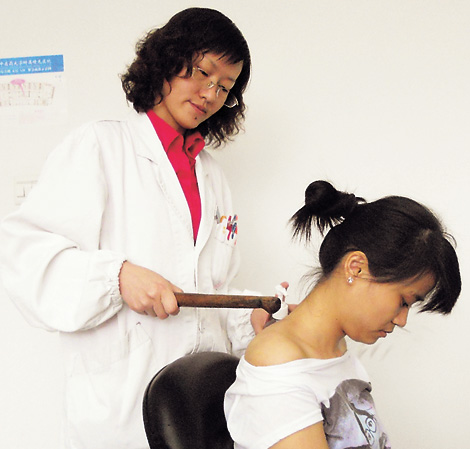Moxibustion box

Makes moxibustion safer (no burning of skin), more precise and easier
This is a small red sandalwood box with holes on four sides; it is heat and fire-proofed and contains a copper net layer to concentrate the infrared spectrum on the bottom of the box and spread the heat evenly. It also keeps ash from dropping on the skin. A spring adjusts the height of the burning moxa.
Since 2006 it has been used for 10,000-20,000 patients each year and about 1,000-2000 boxes are sold for DIY practices annually.
This is not a new therapy but a much improved tool. Traditional moxibustion involves burning moxa (usually an herbal stick) on or above acupuncture points. With heat and moxa entering and traveling in the energy channels, it helps unblock energy channels, dispel so-called pathogenic energy and restore balance of yin (cold energy) and yang (hot energy).
However, the venerable therapy has many practical problems, according to Dr Yu Ansheng.
"Most of the roughly produced moxa nowadays do not burn evenly and cannot provide constant heat and radiation. Embers and ash from the moxa stick may burn the skin."
To improve the practice, Dr Yu collected moxibustion boxes used by lay practitioners, he improved the product and by 2006 had produced new boxes.
"The box has greatly improved the safety of moxibustion and it is much easier to practice - you don't have to find a very precise location since the box provides 6 square centimeters of radiation exposure," says Dr Yu.
Herbal stick pounding

Multiplier pain relief with several therapies
Zhen ting, literally "shaking a stick," is an ancient therapy to relieve pain caused by trauma. It involves pounding the sore area with a small wooden stick.
Yu learned from Dr Wang Yuezhen of Shuguang Hospital and invented her own therapy for sore joints, tendons and muscles, combined with zhen ting, acupuncture, moxibustion and fomentation (applying warm towels on the affected areas). She opened a clinic in 1986 and claims treatment is 97 percent effective in relieving pain, especially in the neck, shoulders, lower back and legs.
It also relieves pain of rheumatism and joint problems as well as aftermath of stroke.
It involves a small stick 40cm long and 2cm in diameter and herbal liquor that is crucial in the therapy since it enhances the effect of the stick's pounding to dispel pathogenic cold and improve blood and energy circulation.
Dr Yu learned the therapy in 1995 and opened her own clinic in 2007.
To make the liquor infusion she uses white spirit and she soaks 10 herbs in it for a month. They include chuan wu (monkshood), cao wu (radix aconiti agrestis), ru xiang (frankincense) and mo yao (myrrh).
First she uses acupuncture and moxibustion. Then she applies the liquor infusion to the affected area. She then uses the stick to pound (not hard) around 120 times a minute for 10-15 minutes on each painful area - until the area turns red and feels hot.
Then comes fomentation to strengthen the effect.
"Pain comes from blood and energy blockage so the affected area swells. Gently knocking the area and nearby energy channels can resolve stagnation and improve energy flow so pain and swelling gradually subside," says Dr Yu. The herbal liquor of yang, or warm herbs applied in advance enters the energy channels with the knocking and dispels pathogenic energies such as cold and damp.
For acute pain, two or three treatments are used; chronic pain requires long treatment, 10-20 sessions.
"Each therapy has advantages and disadvantages," says Dr Yu, "We found that the effect of stick pounding is multiplied with the alcohol infusion, acupuncture, moxibustion and fomentation."
We recommend:
